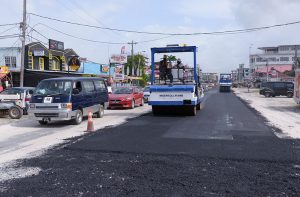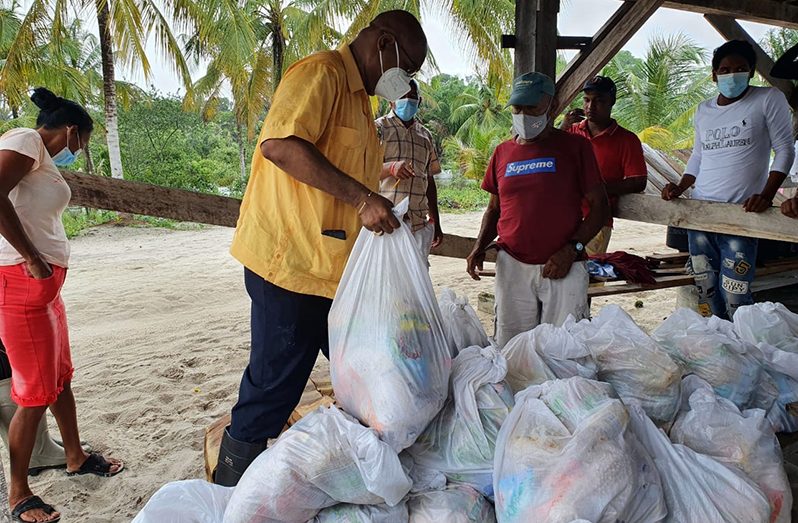–preliminary report to be ready within days
AS heavy rainfall persists countrywide, all ongoing infrastructural projects continue to be affected, according to Minister of Public Works, Juan Edghill.
“They’ve all been affected; mainly the road works and where we’re building sluices and bridges and so on,” the minister told the Guyana Chronicle on Thursday.
He explained during a brief telephone interview that the rains have prevented contractors from moving ahead with certain aspects of their work, since some of these are heavily dependent on good weather conditions.
“Because of the rain and flooding, we can’t get to do paving; we can’t put down the asphalt or do concrete where there is water, so that is the difficulty we’re faced with,” Minister Edghill lamented.

He said that even with the rain, contractors are moving ahead with components of their work that may not be reliant on weather patterns.
“Nothing is stalled; affected, but not stalled. They’re trying to do other things,” Minister Edghill related.
He made specific reference to the Sheriff/Mandela Expansion Project which is less than 60 per cent completed, and currently affected by continued rainfall.
“Last weekend, we advertised that the roundabout at Kitty [Georgetown]; [we advised that] you couldn’t use that area, because we were planning to pave it. Part is paved and part is not paved,” the Public Works Minister noted.
He reiterated that rainfall causes delays in all construction and infrastructural projects. Asked about infrastructural damage, Edghill said that a countrywide assessment has been launched to ascertain same.
“The engineers [are working] to see what damages were done; emergency works that are undertaken, and so on,” Edghill said.
Further, the minister said that the assessment figures, which will also measure the cost of emergency works, is likely to be ready within the next few days.
“We have had to restore bridges; we’ve had to restore roads; we’ve had to install culverts for good drainage and so on,” Edghill indicated.
Meanwhile, authorities have been unable to estimate the cost of the government’s overall flood relief efforts so far.
Director-General of the Civil Defence Commission (CDC), Lieutenant Colonel, Kester Craig, had said that once the flood is over, technical teams would be sourced to conduct a comprehensive socio-economic impact assessment, much like the one which was done following the infamous 2005-2006 floods.
According to a report prepared by the United Nations Development Programme (UNDP), the total impact of Guyana’s December 2005 – February 2006 floods were in excess of GYD$6 billion.
This, the report said, represented 4.6 per cent of country’s Gross Domestic Product (GDP) for 2005.
“As is typical of similar types and magnitude of disasters, damage, which refers to the impact on physical assets and stocks, accounted for roughly 74 per cent of the total impact and amounted to GYD$4.4 billion, [or the] equivalent to 3.5 per cent of GDP,” the report indicated.
As it relates specifically to infrastructure, the UNDP report said that drainage and irrigation components suffered losses of GYD$495 million, stemming from the costs of pumping excess water from flooded areas and the repair of embankments and levees.
In 2014, the Global Facility for Disaster Reduction and Recovery (GFDRR) published a report which stated that approximately 290,000 persons were affected by the 2005-2006 floods, translating to 39 per cent of Guyana’s population.
“The 2005 flood disrupted livelihoods and resulted in long-lasting economic impacts that are estimated to amount to US$465 million,” the report posited,
If further noted that the 2005 deluge exposed structural vulnerabilities in Guyana’s flood mitigation infrastructure.
As a result, Guyana’s Ministry of Agriculture collaborated with the World Bank and other international development agencies to initiate the US$3.8 million Conservancy Adaptation Project (CAP), which was aimed at reducing the country’s vulnerability to flooding.
At a press conference on Wednesday, the CDC Head lamented the fact that even though the past flood was an eye-opener, some of the measures taken subsequently were not sustained.
In the meantime, Edghill said that he is extremely pleased that so far, Guyana’s sea defence structures have held up strongly.




.png)









